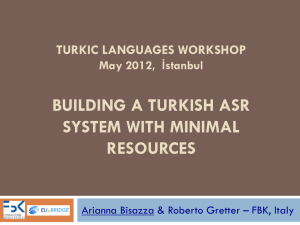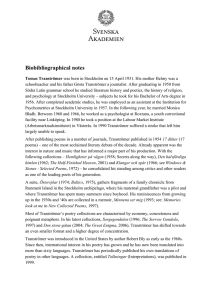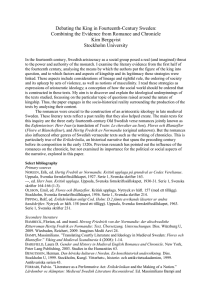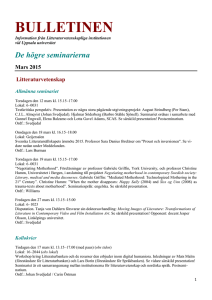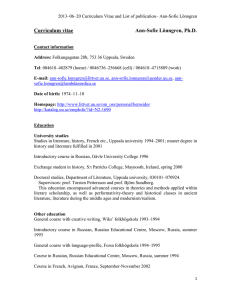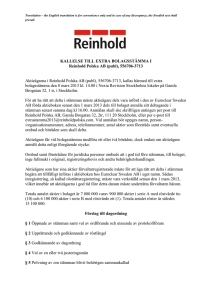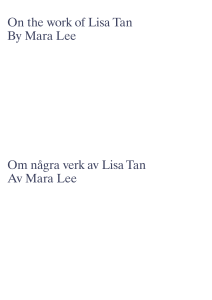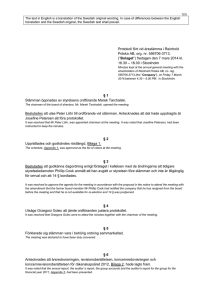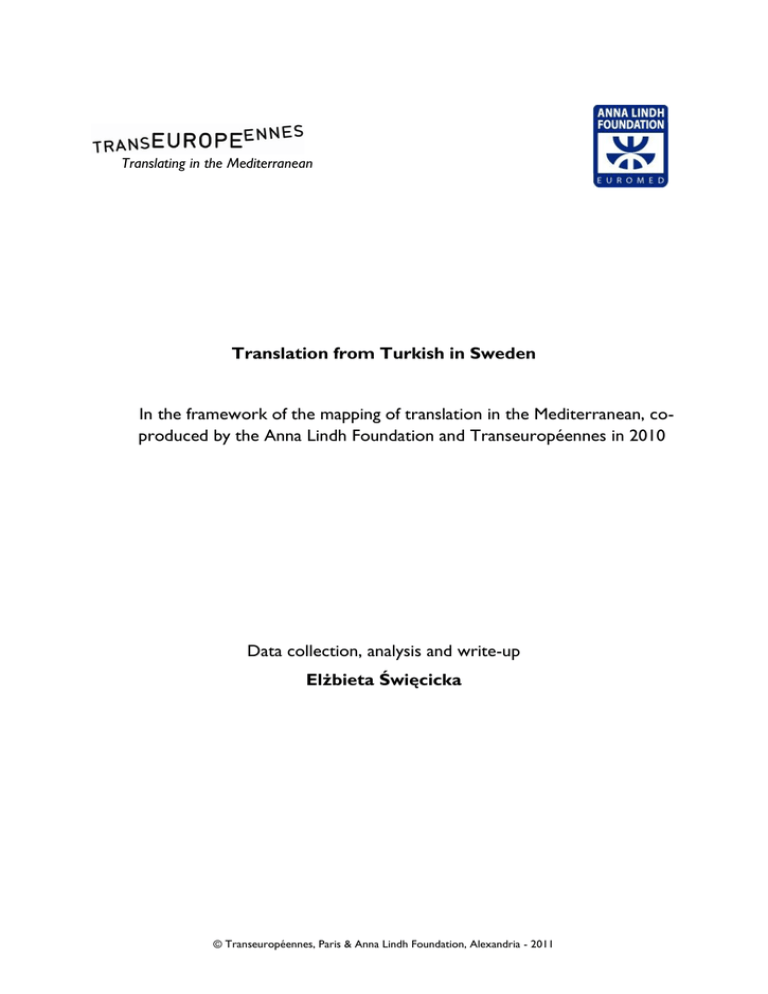
Translating in the Mediterranean
Translation from Turkish in Sweden
In the framework of the mapping of translation in the Mediterranean, coproduced by the Anna Lindh Foundation and Transeuropéennes in 2010
Data collection, analysis and write-up
Elżbieta Święcicka
© Transeuropéennes, Paris & Anna Lindh Foundation, Alexandria - 2011
Preamble
The following study is conducted by Transeuropéennes in partnership with the Anna
Lindh Foundation (Translating in the Mediterranean). It is a component of the first mapping
of translation in the Mediterranean, led since 2010 by Transeuropéennes and the Anna Lindh
Foundation (Euro-Mediterranean program for translation), in partnership with over fifteen
organizations from all over the Union for the Mediterranean.
Sharing a common and wider vision of translation, of the central role that it must play in
Euro-Mediterranean relationships, in the enrichment of languages, in the development of
societies, in the production and circulation of knowledge and imaginaries, the partners
gathered around this project shall use this inventory as a basis to formulate and take long
term actions.
Historical survey1
Once upon a time the Kingdom of Sweden was an expanding great power, influencing
politics and conducting wars. The Swedish kings sought the Ottoman sultans support in
different matters, by dispatching theirs envoys to the Sublime Porte. The Swedish envoys
often returned with the interesting accounts and many times brought objets d‟art and books
that were either purchased or given as gifts.2
Sweden participated in many wars but never waged a war with Ottoman Turkey. As
a result of successful Swedish military campaigns, among the war booty there were
armaments, precious objects and whole libraries, which sometimes contained also Turkish
books.3
The Swedish war activities came to an end after the battle at Poltava when the
Swedish king Charles XII was defeated by the Russian forces. He retreated into the territory
of Ottoman state and asked for Ottoman protection. Since that time, Swedish interest in
things pertaining to the Ottoman Empire became even greater. Demirbaş Şarl as the Turks
called Charles XII, stayed between 1709 and 1714 in Bender, then on Ottoman land. He
developed enlivened diplomatic activity, trying to make the Ottomans an ally against Russia.
Charles XII also used to send his officers and subordinates on scientific expeditions.
Probably at that time, Hans Perman, Chancellery Registrar with Swedish State Office, at the
request of the King bought the poem Lailā and Macnūn.4 The first Turkish publications,
1
This text is partly based on my previously published article “Turkish Literature in Swedish Translation”,
Publication of Oriental Committee, 2003,Vol. 24, Polish Academy of Science, Cracow Branch, 243-252, which is
the main bibliographical reference for the study of the translation of the Turkish literature up to 2002.
2
As the central religious text of Islam, Qur'an, about 1500, was donated to the Swedish envoy Claes Rålamb,
during his mission to Turkey in 1657. In the possession of Royal Library [Kungliga Biblioteket] (KB), the official
name: National Library of Sweden.
3
As another copy of the Qur'an, probably war booty from Prague now in the possession of KB.
4
In the possession of KB.
© Transeuropéennes, Paris & Anna Lindh Foundation, Alexandria - 2011
printed in the first Turkish printing house5, so called Turkish incunabula, were acquired on
the initiative of Royal Library by two envoys to Constantinople in 1736.6
After Sweden purchased grounds in Pera in 1757 and established regular diplomatic
activities, the Swedish diplomats started collecting works of art and Turkish books.7
In Sweden, as in other European countries there existed at the time of the Ottoman
Empire a certain interest in Oriental literature. However Ottoman Turkish literature was
perceived as part of exotic Oriental literature accessible only to specialists. This interest was
mainly among Oriental scholars, translators, diplomats and travelers. The wider reading
audience‟s interest was limited to specific forms like, for instance the Kalila and Dimna
fairytales, translated into Swedish from French, as The Wise Indian Pilpay’s stories [...].8
The first translation of a Turkish book into Swedish was made by a learned orientalist
and translator, Peter Rubens. It was also a selection of Bidpai‟s fables, published in 1762.9
The Swedish legation in Constantinople employed interpreters or translators –
entitled dragomans. Some of them were interested in literature, and from time to time they
collected and translated Turkish texts, just like the last Swedish dragoman, Johannes
Kolmodin.10 But it happened that rather than translate books written by others, they wrote
their own works such as in case of Swedish dragoman and diplomat Mouradgea d‟Ohsson.11
From the moment the Classical period was over, Turks in turn started to develop an
interest in European literature and translated certain literary works from European
languages. They discovered not without inspiration from European literature, that they
needed a less complicated language and literary genres that would be appropriate as a
communication medium with Turkish reading audience, such as newspaper articles, short
stories and plays, in order to describe the Ottoman world which they might wish to change.
The process of the translation of the European literature into Turkish began during the
Tanzimat period, an era of modernist reforms. The development of the printing press in
Ottoman Empire contributed to its acceleration. In Sweden the process of the translation of
Turkish literature started in the beginning of twentieth century.
Notes on earlier translations
The first and only work to be translated from Turkish and published in the preRepublican period was the witty stories of Nasreddin Hoca, published under the title The
5
Founded by Ibrahim Müteferriqa and Ottoman Empire‟s first ambassador to France, Mehmed Efendi in 1727.
Rohström, J. The Turkish incunabula in the Royal Library, 1988. in Turcica et orientalia: studies in honour of
Gunnar Jarring, Transactions. Swedish Research Institute in Istanbul.
7
As the Anthology of Turkish Poetry, from about 1650, that was acquired by the Swedish diplomat Gustaf
Celsing. Books were bought also by private persons as Johan Hedenborg a Swedish traveller and medicine who
during his visit in Constantinople in 1825 purchased a couple of Turkish manuscripts.
8
Kalila wa-Dimna or Den wise Indianens Pilpay Sagor, Stockholm, 1745.
9
Fortsättningen af den wisa Indianen […], published 1762 in Stockholm, see G. Jarring in Meddelanden 12/1987.
10
Kolmodin‟s translations of Turkish poets. See below and also G. Jarring, Meddelanden 1/1976.
11
Tableau Général de l’Empire Ottman, 1790.
6
© Transeuropéennes, Paris & Anna Lindh Foundation, Alexandria - 2011
Jokes and Pranks of Nasreddin Hoca, or Parables from the Days of Timur Lenk12. The respective
Swedish and Danish versions, with Arthur Sjögren‟s amusing illustrations, were published in
parallel in Stockholm and Copenhagen in 1902. The translator was Gustav Noring who as an
eighteen-year-old settled in Constantinople, converted to Islam, and adopted the name Ali
Nouri. After 1928, he took name Nouri Dilmaç, that is to say, Nouri Interpreter or Nouri
Dolmetscher. Ali Nouri became an Ottoman diplomat, a writer, a bibliophile, and the man
behind the idea of creating a National Turkish Library.
The next selection of Nasreddin Hoca‟s anecdotes appeared in 1928, Nasreddin
Hodscha: Turkish Fairytales and Humorous Storie.13The author was Fredrik Böök, a Swedish
literary historian, who was introduced to Nasreddin Hoca‟s world in Constantinople in 1922
by Johannes Kolmodin, a Swedish diplomat, translator/dragoman and specialist in Turkish
archives. More recently; Herman Stolpe published a third selection of Nasreddin Hoca‟s
anecdotes in 196614. This thin volume was published for a second time under a slightly
modified title in 1980, within the series Oriental Proverbs and Sayings.15
The first book translated into Swedish, following the establishment of the Republic,
was The Shirt of Flame16 (Ateşten Gömlek) by Halide Edib Adıvar, a writer considered to be the
mother of contemporary Turkish literature. The Shirt of Flame appeared in 1928 and is a
description of the struggle between the Turks and the occupiers who were planning how to
divide the remains of the Empire. The book‟s translator, Hjalmar Lindquist, knew Turkish
and Turkish-Ottoman well and, as he himself wrote, had spent seven years „amongst the
Turkish tribes‟. He also knew the writer personally, and could discuss with her the
translated text. Lindquist was helped in his Turkish studies by the previously mentioned
Johannes Kolmodin, as well as by the Turcologist and missionary from Lund, Gustav
Raquette.
In 1947 there appeared a subsequent book in Swedish by the same author, The Clown
and His Daughter.17 Halide Edib wrote it in English during her self-imposed emigration that
constituted a protest against the policies of Kemal Atatürk. This is a noteworthy work by
the writer.
In this very same year Erik Gamby, a writer and cultural specialist, published a
selection of poems by fifteen Turkish poets: Yunus Emre, Karacaoğlan, Abdülhak Hamid,
Ahmet Haşım, Yahya Kemal, Necip Fazıl Kısakürek, Hasan Dinamo, Suphi Taşan, Orhan Veli,
Ilhan Berk, Cahit Külebi, Melih Cevdet, Oktay Rifat, Sabahhatin Küdret and Sefer Aytekin for
as he writes in the introduction, “Turkish verse has never been offered to Swedish
readers.”18
12
Nasreddin Khodjas upptåg och skämt... A Swedish rendition of titles is given in the footnotes. In the text, there
the original English titles for the translations, as far as they exist, are preserved. Complete bibliographical data
is to be found at the end of the article.
13
Nasreddin Hodscha. Turkiska sagor och skämthistorier. Böök‟s selection is based on the sources published by J.
A. Decourdemanche (1878), A. Wesselski (1911) and H. D. Barnham (1923) See also Nasreddin Hodja på
svenska [Nasreddin Hodja in Swedish] by U. Ehrensvärd, Dragomanen 1/1996-97.
14
Turkisk livsvisdom: Ordspråk och sentenser, Kolibri.
15
Turkiska ordspråk, by Lts Publishing House.
16
Eldskjortan
17
In Swedish it was given the title Rabia, koransångerska [Rabia, the Koran Singer], translated by L Westlinger
18
Österland: tolkningar av modern turkisk och japansk lyrik [The East: Getting Closer to Contemporary Turkish and
Japanese Poetry] His selection was based on Derek Patmore‟s book The Star and the Crescent, London 1946.
© Transeuropéennes, Paris & Anna Lindh Foundation, Alexandria - 2011
This is not quite true, as in 1921 the above mentioned Johannes Kolmodin published,
in the Sunday supplement to the daily Dagens Nyheter, translations of patriotic verse by the
following poets: Orhan Seyfi‟s, Ahmet Celal Sahir‟s and also the well-known poem by
Mehmet Akif The March of Freedom. Gunnar Jarring adds that, Kolmodin quotes in private
correspondence from 1917, the unpublished translations of Yunus Emre‟s hymns.19
Inspirers, Enthusiasts and Translators
In the 1950s isolated cases of immigrants, from intellectual circles arrived in Sweden
from different countries including Turkey. They undoubtedly played a part in the appearance
of a series of translations from literatures of the Orient in the second half of the 1950s. The
series was published by a group, initiated by Carl Elof Svenning, that was called the
International Book Club20 which had set itself the goal of acquainting Swedish readers with a
“different art of narration”, and through it was written in the introduction to the first book,
“the addition of prose translations of contemporary Asian writers to the treasure house of
literature present in Sweden”. In 1958, Carl Elof Svenning published a small volume of short
stories written by Arab, Armenian, Iranian, Pakistani and Turkish writers entitled
Contemporary Eastern Story Tellers.21 As it appears the short stories were translated from
European languages. Turkish literature is represented in the anthology by three short
novellas written by: Yakub Kadri (Karaosmanoğlu), Jusuf Ziya and Orhan Hancerlioğlu. In the
introduction the author of the anthology, thanks the poet and photographer Lütfi Özkök resident in Sweden - for the selection of texts, claiming also that no similar anthology has
arisen in Europe.
The International Book Club issued, with a similar intention, a journal entitled We
and World Literature, in which the poems of Yunus Emre were published in 1972.22
Lütfi Özkök is a poet, translator of French literature and first and foremost, a
respected photographer who specializes in the portraits of writers including many Nobel
Prize winners. He is one of the first Turkish, intellectual emigrants who came to Sweden in
the early 1950s.
Thanks to his efforts, a modest selection of Turkish poems was released in 1953. The
translation was a join work between himself, his wife, Anne–Marie Özkök, (previously Miss
Anne–Marie Juhlin, whom he met in Paris) and a leftist literary man of letters, Lasse
Söderberg. The little volume entitled Bread and Love23 was published in one hundred copies.
Lütfi Özkök has chosen the poems of Cahit Külebi, Orhan Veli, Oktay Rifat, Fazıl Hüsnü
Dağlarca, Melih Cevdet, calling these poets “the salt of our literature”.
According to Gamby, translations from Turkish into English were made by “a female Turkish university
graduate”. The Patmore‟s book was not accessible to me at the moment of writing this article.
19
Svenska Forskningsinstitutet i Istanbul, Meddelanden 1/1976, p.42.
20
Internationella Bokklubben
21
Moderna österländska berättare
22
Vi och världslitteraturen 1/1972.
23
Brödet och kärleken, edition by Metamorfos
© Transeuropéennes, Paris & Anna Lindh Foundation, Alexandria - 2011
Another volume of poetry which bore the title once used in 1953 - Bread and Love:
Five Poets24- was prepared by Lütfi Özkök in 1976, in cooperation with the known writers
Artur Lundkvist, Lasse Söderberg and Anne-Marie Özkök as translator. The volume was
published by the leftwing publishing house Tiden. Here were to be found five poets: Nazım
Hikmet, Fazıl Hüsnü Dağlarca, and three poets from the avant-garde literary group Garip.
Anne-Marie not only shared Lütfi Özkök‟s love of French literature, but also herself
started to take an interest in Turkish literature and in translation of Turkish poetry. She
selected and prepared an extensive collection of slightly surrealist, ironic and existential
poems by poets from the group Garip: Orhan Veli, Melih Cevdet Anday and Oktay Rifat.
Two elegant volumes have appeared from the planned trilogy on Orhan Veli and Melih
Cevdet Anday.25 She also translated isolated novellas of e.g. Sait Faik26, and other poems
published amongst other places in the journal Artes,27 as well as a volume of Bülent Ecevit‟s,
the poet and statesman, verse from various periods.28Anne-Marie Özkök‟s premature death
meant that she did not publish the edition with Oktay Rifat‟s verse.
A sizeable section of the Swedish intellectual establishment appeared to foster the
conviction that an individual is merely a piece of matter in the face of history, of politics and
technology and that it is necessary to strive to change the system of these forces through
radical methods and at least to support those who hold similar views in the so-called Third
World. As far as Turkish literature is concerned, there prevailed the view (expressed, by
among others, the pen of a Swedish critic in a leftwing newspaper) that “Turkish literary
works lack a common aesthetic platform, that though the description of the harsh conditions
of life for an Anatolian peasant is not devoid of genuine compassion there is within the
stories an absence of strong ideological interpretation.” Other writers were accused of
blindly imitating the forms and literary genres of the West29. In this context, it is
inconceivable that the decision was not taken to publish, for example, Mahmud Makal‟s book
A Village in Anatolia30, which had been translated into over twenty languages and awarded
with several prizes.
The poems of the avant-garde Turkish poet, Nazım Hikmet gained many admirers. In
the 1970s two volumes of Hikmet‟s poems, chosen in accordance with the spirit of the
times, were published. In 1970 a selection of verse from various periods31, translated from
French by Arne Häggqvist, and in 1974, The Moscow Symphony32 which was translated from
English by the esteemed Swedish writer the late Göran Tunström.
Barbro Karabuda and Güneş Karabuda translated and published in 1958 a collection
of short stories by Tahsin Yücel, Intoxication and Other Stories.33 Both Barbro Karabuda and
24
Brödet och kärleken. Fem turkiska poeter, within a series FIB: s lyrikklubbs bibliotek.
Jag lyssnar till Istanbul [I’m Listening Intensely to Istanbul] and På nomadhavet [Incessant Wandering] , through the
cooperation of Lütfi Özkök and Lasse Söderberg.
26
A Garden, in cooperation with Birgit N. Schlyter, the Turkologist at Stockholm University.
27
2/75 F. Hüsnü Dağlarca, O. Rifat, together with Lütfi Özkök.
28
Mot källan [Towards the Source]. L. Özkök has also participated in translation into Danish of Bülent Ecevit‟s
poems, Bugün Yarın Idag Imorgon, together with Jørgen Nash and Lars Morell. Køpenhavn : Förlaget SOC 1983.
29
Knut Hansson, Provinsiell och bisarr dikt [Provincial and Strange Creativity] in Aftonbladet 26.08.1963
30
Bizim Köy, first edition 1950.
31
Dikter om nu och alltid [Poems about Now and Forever].
32
Moskvasymfonin, FIB: s lyrikklubb. The translation was based on the English version by Taner Baybar‟s.
33
Den stora berusningen[
25
© Transeuropéennes, Paris & Anna Lindh Foundation, Alexandria - 2011
Güneş Karabuda are known for their many books and documentaries about Turkey and also
other countries. Güneş Karabuda is also a photographer who uses to portray interesting
personalities.
Ulla Lundström, translator and journalist began her creative activities presenting
Nazım Hikmet in a radio program in 1970, along with poet and literary critic Göran
Sommardal. She also translated several of Demir Özlü‟s short stories as Vodka, A writer at the
Disco, Pharmacy and others in different anthologies.34 Demir Özlü is a writer, resident in
Sweden, who often touches on the subject of exile. Özlü‟s another short story On Bellman's
Street, was translated by Turcologist and literary critic Jitka Zamrazilová-Jakmyr.35
Another writer translated by Ulla Lundström is a young Turkish writer Aslı Erdoğan.
Two novels by her, Den mirakulöse mandarinen36 and Staden i den röda kappan,37 and a short
story Fåglar av Trä38 recently published have been very well received by critics‟.
Ulla Lundström also translated one of the poems of Özkan Mert Fight My Heart!
(Kırlangıçlar, Kırlangıçlar)39. The next collection of Mert‟s poems, Emigration Blues40 has been
translated by Claire B. Kaustell and was published in 1999.
Both Ulla Lundström and Claire B. Kaustell were charmed by Aziz Nesin‟s amusing
and witty short stories, which appeared in two separate collections: Satirical Tales41
translated by Claire B. Kaustell and Are there No Donkeys in Your Country? translated by Ulla
Lundström.42 (The Swedish titles were given by the translators). The adventures experienced
by the heroes of Nesin‟s books are not those of Don Quichote. Life confronts them with
the bickering of government departments, the police, the army, the neighbours and the
family. Paradoxically the situations in Nesin‟s short stories contain ideas superficially similar
to those of Hašek‟s in The Good Soldier Švejk, i.e. description of the world that has become
irrational. For Nesin an element of this irrational world was, among other things, Islamic
ideology for which reason he financed and supported the publication of The Satanic Verses in
Turkey.
When the well-known Turkish writer Yaşar Kemal made his appearance on the
Swedish literary scene in the beginning of the 1970s, he was well received by Swedish
intellectuals and less desirably by radical Kurdish émigré circles, partly because he wrote in
Turkish, not in Kurdish. But hiss several-year stay in Sweden was a fruitful period for him as
a writer in terms of publications. The list of eighteen titles that have so far been published
begins with A Dirty Story and Other Short Stories published in 1967, Mehmed My Hawk in 1970,
Mehmed My Hawk II in 1973, The Legend of the 1000 Bulls, etc.43 Several works have been
republished number of times. All his books that have been translated into Swedish from
English translations made by his first wife, Thilda Kemal, and also from French and German.
34
Vodka, En författare på diskotek, Apoteket
”På Bellmansgata” in Stockholm Öyküleri published in literary journal Ariel
36
Muzizevi Mandarin
37
Kırmızı Pelerinli Kent
38
Tahta Kuşları from 1997.
39
Kämpa mitt hjärta, Skriptor 1981.
40
Exilens blues
41
Satiriska sagor
42
Finns det inga åsnor i ert land?
43
En smutsig historia och andra berättelse, Låt tistlarna brinna, Och de brände tistlarna, De tusen tjurarnas berg, etc.
See the complete Swedish bibliographical data at the end of the article.
35
© Transeuropéennes, Paris & Anna Lindh Foundation, Alexandria - 2011
Every year there was speculation concerning the awarding to Yaşar Kemal of the
Nobel Prize in Literature. That Sweden is the country that presents this prestigious award is
something of great significance in relation to the translation of world literature.44
But it appeared that Orhan Pamuk‟s star has eclipsed Yaşar Kemal‟s fame. Pamuk is
an adherent of the classical art of story writing, though obviously not in the style of the tales
from a thousand and one nights or the stories of the folk bards – the meddahs. Pamuk
incorporates himself within the European method of story writing à la Joyce, Potocki,
Bulgahov, Faulkner, Lawry, Borges and for certain the art expounded by Cervantes. The
wanderings of the main hero in The Black Book (Kara Kitap)45 are simultaneous to the reader‟s
wandering through literature. Another description of wandering and the experiencing of
contemporary adventures are contained in the book The New Life (Yeni Hayat).46This book
was translated from Turkish by Dilek Gür and published in 1996.
Pamuk is fully aware that, in Kundera‟s words, whose book L’art du roman is
doubtless not unfamiliar to him, the novel is a European concept. Through the lips of
Osman, the hero of The New Life, he speaks in a somewhat self-effacing way:
“[..] zaten, roman denen modern oyuncak, Bati medeniyetinin bu en büyük buluşu,
bizim işimiz değil...bu yabancı oyuncağın içinde nasıl gezineceğimi hala bir türlü
cıkaramadığım için...”
[…and what‟s more the fact is, that this new toy, which we call the novel, and which
is the greatest invention of Western civilization, just isn‟t for us… I still am unable to
understand how it is that I find myself moving within the sphere of this alien
game…]47
Nonetheless, as a writer he tries intensely to share the European passion for solving
the puzzles of existence, with his novels being full of intertextual associations. The strongest
leitmotif that runs through all of Pamuk‟s novels to date is the search for identity within a
new complicated reality – a subject matter of extreme importance not only for the heirs of
The Ottoman Empire, but equally for the inhabitants of a multiethnic Sweden and certainly
equally for the inhabitants of the new common Europe. In The White Castle (Beyaz Kale),
published in Sweden already in 1992, Pamuk formulates it thus: one cannot be oneself
without being able to be somebody else. This book appeared in the joint translation of
Kemal Yamanlar and Anne-Marie Özkök.
44
As I wrote in my first article about translation of Turkish literature into Swedish in 2002:“It seems that if the
Nobel Prize is to be awarded to a Turkish writer then this accolade will befall Orhan Pamuk and not Yaşar
Kemal.” The Nobel Prize in Literature was awarded to Orhan Pamuk in 2006.
45
Svarta boken. The Swedish version is based on B. Brendemoen‟s Norwegian and G. Gün‟s English translations.
46
Det nya livet
47
The same fragment has been quoted earlier in the article Den turkiska litteraturen [Turkish Literature] by
Elżbieta Święicka & Tuula Kojo, in Tradition och nyskapande [Tradition and New Creativity] edited by I. Svanberg,
Lund 1997. Tuula Kojo is a translator of Turkish literature into Finnish. She gained distinction for the
translations of Orhan Pamuk‟s novels.
© Transeuropéennes, Paris & Anna Lindh Foundation, Alexandria - 2011
The subsequent book, The House of Silence (Sessiz Ev) was translated from Turkish by
Dilek Gür, 48 but My Name is Red (Benim adım kırmızı) was translated into Swedish, as The
Black Book, from English.49
Since Pamuk was awarded the Nobel Prize in Literature in 2006, Sweden‟s oldest
publishing house Norstedts attained sole rights of publication of his books in Sweden. In
2006 Norstedts published his book Istanbul Memory of a City, translated from English.50 But
then over a relatively short time, besides the Nobel lecture, My Father’s Suitcase, translated
by Birgit N. Schlyter,51 published two novels translated from Turkish by Mats Müllern: Mr.
Cevdet and His Sons (Cevdet Bey ve Oğulları), Museum of Innocence (Masumiyet Müzesi) and a
collection of essays - Other Colors: Essays and a Story (Öteki Renkler. Seçme Yazılar ve Bir
Hikâye).52
Certain works have been published by small private publishing houses thanks to
financial help from foundations. In this way there have appeared in Swedish an edition of the
novellas of Gülten Dayıoğlu Discarded 53 (Geride Kalanlar) in Saffet Eraybar‟s translation and
edited by Annika Ekström as well as Osman Şahin‟s Red Wind (Kırmızı Yel) in Cumhur Doğan
Gür‟s and Annika Ekström‟s translation.54
In most cases the Turkish writers are translated and published in Sweden as the
result of private efforts of interested intellectuals and cultural workers.
The novels of the prose writer and eminent journalist Çetin Altan were published
both by the well-known publishing house Gidlunds – The Great Surveillance (Büyük Gözaltı) 55
and by the small publishing house Zaza. Zaza published Altan‟s three books - Whisky (Viski), A
Handful of Sky (Bir Avuç Gökyüzü) and A Little Garden (Bir Küçük Bahçe).56 These last three titles
appear in translations by Ruth Sylwan and Eshat Ayata. Ayata has also translated into
Swedish the poetry of Ahmet Arif, I Tore Off the Chains in Yearning (Hasretinden prangalar
eskittim).57
Sabahattin Ali‟s novel, The Devil in us (Içemizdeki Şeytan)58 in Said Aslan‟s translation,
and Güngör Dilmen Kalyoncu‟s play The Victim (Kurban)59 reached the hands of a Swedish
readership in a similar way. The latter was translated by Yavuz Baydar and published by the
small publishing house Halk Oyuncuları.
48
As Det Nya Livet and Det tysta huset
Mitt namn är Röd
50
Istanbul. Minnen av en stad, translated from English by Tomas Håkansson.
51
Pappas resväska. The translation of the Nobel Lecture for the Nobel Foundation in Stockholm was made by
Claire. B. Kaustell.
52
Herr Cevdet och hans söner, Oskuldens museum and Andra färger
53
In Regnbågen, Mellanösterns Förlag
54
Den röda vinden
55
Mordet på silkesmasken, translated from French by Britt Arenander.
56
Whisky, En handfull himmel, Den lilla trädgården
57
Min längtan har slitit ut bojorna. Other publishing houses of this character are Apec in Spånga and Storge in
Visby which published Ayfer Tunç‟s Sagan om herr Aziz, (Aziz Bey Hadiseleri) translated by Mats Müllern and
Hamdi Özyurt‟s books, probably belonging to the Kurdish literature written in Turkish. Özyurt‟s books are
translated by Claire B. Caustell: Tjugo träd och en apelsin (Yirmi Ağaç Tek Portakal), Från våra fönster (Pencereler)
and also by Mats Müllern: Olycksfåglarna (Feleğin Bir Kuşu Var).
58
Djävulen inom oss
59
Offret
49
© Transeuropéennes, Paris & Anna Lindh Foundation, Alexandria - 2011
It was probably also the case with the release of Ömer Zülfü Livaneli‟s book The
Perfect Hapiness.60 Livaneli is a very popular Turkish musician, a film director, a politician but
also novelist, who spent some years in exile in Sweden. His book was translated by Eva
Mazetti-Nissen and published by one of the smaller publishers, Clarkson Publishing AB.
Sometimes the translations are published by authors or translators at Författares
Bokmaskin, (Writers‟ Book Machine) where the author‟s text is printed-on-demand from
manuscript. Författares Bokmaskin was founded in Sweden in 1972, offering authors selfpublishing service. The bilingual volume of Hikmet‟s play and poems under the title The Multicolored Honeysuckle. Ferhad and Şirin, was translated and published by Sebüktay Kaan in such a
way.61 Another example of using this publishing possibility was the edition of Süleyman
Çelebi‟s Mevlid-i Şerif, a fifteenth century poem about Prophet Mohammed‟s birth, translated
and edited by Sidney W. Hage.62
There are also several eminent poets and writers whose works, mostly short stories,
have been translated and brought to the (Swedish) light, thanks to the efforts of enthusiasts
of Turkish literature and published in cultural literary journals, such as Dragomanen.63Here is
to be included the names of Sevgi Soysal, Necati Cumali and Sait Faik. Soysal‟s short story
Tante Rosa I Love You was translated by, Birgit N. Schlyter. Necati Cumali‟s, The Street of My
Childhood64 was translated by Lena Ullman.
This concerns also Sait Faik, the eminent short story writer. Faik‟s heroes are often
people who like him drown their sense of disgust at existence in alcohol and who do not
wish to come to terms with the fact that omni puissant social rules have dominated them and
assigned the range or rather limited of their possibilities. Only three of his short stories, Last
Birds (Son Kuşlar),65 in Ulla Lundström‟s translation, A Garden (Bir Bahçe),66 in a translation by
Birgit N. Schlyter and Anne-Marie Özkök and At the Fountain by Birgitta Kurultay67 were
published in Swedish.
Individual poems and short stories by Oktay Rifat, Fazil Husnu Dağlarca, Özkan Mert,
Lütfi Özkök, Nazım Hikmet, Aziz Nesin and others have been published in the journal Artes,
created by among others by the Swedish Literary Academy,68 in the daily newspaper Dagens
yheter, literary journals Karavan/Halva världens litteratur,69 and Ariel70, and in previously
mentioned Dragomanen.71
60
Fullkomlig lycka (Mutluluk)
De mångfärgade kaprifolerna & Ferhad och Şirin, Stockholm : Författares Bokmaskin.
62
In Stockholm, 1984.
63
Dragomanen, an annual of the Swedish Research Institute in Istanbul and Society of Friends of the Research
Institute in Istanbul, devoted to the culture of Turkey and Middle East. The journal was previously, until 1996,
published under the title Meddelanden, under the editorship of Gunnar Jarring and Ulla Ehrensvärd.
64
Min barndomsgata
65
De sista fåglarna
66
En trädgård
67
Vid fontänen
68
Artes, magazine for art, music and literature was closed 2005.
69
Halva världens litteratur/Karavan published among others Yunus Emre‟s poem in a bilingual Turkish-Swedish
form translated by C. Kaustell (1/1992); a short story of A. Nesin En kvinna per sex män in G. Tibblin‟s and N.
Dağdeviren‟s translation (1/1994); a short story of Y. Kemal Hör på broder in C. Kaustell‟s translation (1/1997),
as well as reprinted fragments of Hikmet‟s Moskvasymfonin (2/1992); the excerpts from Svarta Boken in 3/1995;
and M.C. Anday‟s Nocturne (1/1997).
61
© Transeuropéennes, Paris & Anna Lindh Foundation, Alexandria - 2011
Turkish-Cypriot literature is represented by the collection of poems by the Turkish
Cypriot poet Osman Türkay,72 the joint work of the Turcologist and translator and the
writer Bengt Liljenberg. Jitka Zamrazilová-Jakmyr has written numerous reviews in various
scientific journals and literary magazines and has translated a couple of Ferit Edgü‟s and Tarik
Dursun K.‟s73 short stories and Yüksel Peker‟s poems.74
The literature of documentary character is not widely represented among translated
works. One of them is Gülderen Sonsuz‟s Those who were forgotten at the last stop
(Sondurakta unutulanlar:gerçek hayat öykülerinden olusmaktadır), about the women from Kulu
village, who came to Sweden to work in the 1960's with high expectations and now live in
solitude in retirement homes.75
In order to make the list of names of Turkish writers translated into Swedish still
more representative one would need to add several new names, notably Ahmed Hamdi
Tanpınar, Adalet Ağaoğlu, Elif Şafak, Ayşe Kulin, Bilge Karasu, Emine Sevgi Özdemir, Latife
Tekin, Muratan Mungan and there are many others. Otherwise it appears to be reasonably
comprehensive. As far as the v o l u m e of translated books goes, the majority was
translated via a third language, in other words not directly from the original.
If one takes into consideration the n u m b e r of names of translated writers, then it
appears that the works for the majority of them were translated from the original language.
If the translation into English, French or German was done well, and in addition with the
participation of the author (casus of Yaşar Kemal and the translations of his wife, casus
Orhan Pamuk and translations of Güneli Gün, a Turkish writer writing in English) then the
fact that the translation was made from English into Swedish is usually not taken as
something defective or worse in its own right. The result could be judged as an independent
work. And besides, if it were not for just such translations the image of Turkish literature in
Sweden would be even more lacking.
A part of the published translations resulted from the joint efforts of literary
enthusiasts who have read many different texts while being my students of Turkish
Literature at Uppsala University, 1982-2005,76 both Scandinavians as well as native speakers.
The meetings devoted to Turkish literature continued during 15 years (1990-2005) as a
literary seminar, led by Birgit N. Schlyter a specialist in Turkish studies at Stockholm
University.
Some of the course participants have been or have become professional translators and
experts in the field of Turkish literature. Almost all of the participants are still engaged in
translation for pleasure. Until Orhan Pamuk received the Nobel Prize, publication of Turkish
70
Literary journal Ariel, published 1993-2006.
A single poem of Hikmet, in a bilingual Turkish-Swedish form and in Birgit N. Schlyter‟s translation, was
newly published in No 5/2001.
72
Havets ljus: dikter
73
”Hälsa henne att jag är förälskad” [Tell her I'm in love] in Karavan 2/2000
74
Edgü‟s “Mirza” in Karavan 1/2005; Peker‟s “Macaristan günlügü 1984”, both as separate volume and in
Minaret, a magazine about Swedish Muslim culture.
75
De som glömdes vid sista hållplatsen
76
Turkish Studies at Uppsala University are continued, but with a stronger emphasis on Turkic Linguistics.
71
© Transeuropéennes, Paris & Anna Lindh Foundation, Alexandria - 2011
authors in Sweden seems to be caused by the initiative of private persons who had a deep
fondness for Turkish literature.77
Knowledge of Turkish literature was deepened in its original environment through
two intensive courses held at the Swedish Research Institute in Istanbul. One – offering
survey of history of Turkish literature and the other – focusing on the modern Turkish
literature of the 20th century. The group of translators and literary scholars had the
opportunity to listen to excellent speakers – Turkish eminent writers and the best specialists
in the field: Adalet Ağaoğlu, Pınar Kür, Talât Halman, Jale Parla, Victoria Holbrook, Mehmet
Kalpaklı, Metin And, Ilhan Başgöz, Murat Belge, Süha Oğuzertem, Laurent Mignon and
others.78
Both courses were thoroughly organized on the initiative of Birgit N. Schlyter,
Department of Oriental Languages at Stockholm University and Elisabeth Özdalga, the
former director of the Swedish Research Institute in Istanbul.
Professional education for interpreters and translators
Information about these praiseworthy activities had certainly reached both the wider
audience and also specialists. Due to the inspiration of another great enthusiast of making
Swedish readers familiar with foreign literatures, Lars Erik Blomqvist, and thanks to the
engagement of scholars and translators of literature Anders Bodegård and Lars Kleberg, it
was possible to create at University College of Södertörn the education of professional
interpreters of literature of different languages. Birgit N. Schlyter become responsible for
organizing and conducting the education of interpreters of Turkish language and literature,
which seems natural and rewarding in view of the many years coherent activities. Through
this two year training, Turkish literature has gained new translators and as a positive
outcome; new readers?
At Stockholm University Turkish studies are in progress as supplement to Central Asian
Studies. Advanced students listen to the lectures about Turkish literature (together with the
students from Middle East Studies) and read literary texts.
Contemporary translators from Turkish into Swedish
Ulla Lundström, Claire B. Kaustell, Jitka Zamrazilová-Jakmyr, Mats Müllern,
Birgit N. Schlyter, Lena Ullman, Martin Palm, Birgitta Kurultay.
77
Most of the texts of different Turkish writers, translated by late Anne-Marie Özkök, Ulla Lundström, Tuula
Kojo, Lena Ullman, Mats Müllern, Cecilia Edfeldt, Lena Wester, Barbro Cağlar, Sven Johnsson, Peter Arvidsson,
Sevgin Ildeniz, Güliz Holago, Annika Engström, Marianne Komar, Ümit Alagök, Andreas Eraybar and the host of
these gatherings, Birgit N. Schlyter, are still waiting to be published. The poems of Baki and Yunus Emre in
Peter Arvidsson‟s translation and the prose of Oğuz Atay in Öykü Andersson‟s, ought not to be forgotten.
78
See detailed report about the Graduate Course in Turkish Literature 2001, in Dragomanen 5/2001.
© Transeuropéennes, Paris & Anna Lindh Foundation, Alexandria - 2011
Turkish literature translated into Swedish79
Fiction
Individual writers in separate publications, in periodicals and in anthologies
Adıvar, Halidé Edib, Eldskjortan, Stockholm: P. A. Norsteds 1928 **H. Lindqvist
Adıvar, Halidé Edib, Rabia, Koransångerskan, Stockholm: Hökerbergs 1947 *L. Westlinder
Ali, Sabahattin, Djävulen inom oss, Tumba: Hedenlans 1978 **S. Aslan
Altan, Çetin, Mordet på silkesmasken, Stockholm: Gidlunds 1976 *B. Arenander
Altan, Çetin, En handful himmel, Stockholm: Zaza 2000 **R. Sylwan, E. Ayata
Altan, Çetin, Whiskey, Stockholm: Zaza 2000 ** R. Sylwan, E. Ayata
Altan, Çetin, Den lilla trädgården, Stockholm: Zaza 2002 ** R. Sylwan, E. Ayata
Anday, Melih Cevdet, På nomadhavet, Lund: Ellerströms 1995 **A-M. Özkök, L. Söderberg, L.
Özkök
Arif, Ahmed, Min Längtan har slitit ut bojorna, Stockholm: Hiddekel 1992 **E. Ayata
Brödet och kärleken, modern turkisk poesi, Stockholm: Metamorfos 1953 **L. Söderberg & L.
Özkök
Brödet och kärleken, fem turkiska poeter, selected and edited by L. Özkök, **A-M. Özkök, A.
Lundqvist, L. Söderberg, Tiden: Stockholm 1976
Cengizkan, Ali, Den grekiska dossieren, (poems, with photographs by Constantine Manos),
Stockholm: Yarin, 1988 **Gürhan Uçkan
Cumali, Necati, ”Min barndoms gata”, (Aklim Arkada Kalacak), in Dragomanen 2/1998 **Lena
Ullman
Dayioğlu, Gülten, Regnbågen [The Rainbow], Stockholm: Mellanösterns 1983 **S. Eraybar
Dilmen, Kalyoncu Güngör, Offret, Stockholm: Halk Oyuncularї 1982 **Y. Baydar
Dursun, Tarik, K. ”Hälsa henne att jag är förälskad” [Tell her I'm in love] in Karavan 2/2000
**Z. Zamrazilová-Jakmyr
Ecevit, Bülent, Mot källan, Stockholm: Fripress Bokförlag 1985 **A-M. Özkök
Edgü, Ferit, ”Mirza” in Karavan, 4/1994 **J. Zamrazilová-Jakmyr
Erdoğan, Aslı, Den mirakulöse mandarinen, (Muzizevi Mandarin), Malmö: Rámus 2008 **U.
Lundström
Erdoğan, Aslı, Staden i den röda kappan, (Kırmızı Pelerinli Kent), Malmö: Rámus 2010.
Fragments of this book were also published in Dragomanen, 12/2008-2010) and in Karavan
1/2009 **U. Lundström
Erdoğan, Aslı, ”Fåglar av Trä”[Birds of Wood], 1/2009 in Karavan **U. Lundström
Faik, Sait, ”De sista fåglarna”[The Last Birds], in Fjärran ifrån och nära, önskenoveller från
Radions P1[…], edited by G. Ekroth, Stockholm: Sveriges Radios förlag 1996 **U. Lundström
Faik, Sait, ”Vid fontänen” (Havuz Başı), in Karavan 1/2009 ** B. Kurultay
Faik, Sait, ”En trädgård”, (Bir Bahçe), in Meddelanden20/95 **B. N. Schlyter, A-M. Özkök
Gürpınar, Hüseyin Rahmi, ”Två vilda systrar” in Dragomanen 8/2004 **B. N. Schlyter et al.
Hikmet, Nazım, Dikter om nu och alltid, Stockholm: Gidlunds 1970 *A. Häggqvist
79
The names of the translators are introduced by star after the date of publication. Two stars at the
translator's name means that the book was translated from Turkish.
Writings in Turkish written by Kurds, (A)Syrians and Armenians, translated into Swedish, are largely not
discussed at this occasion.
© Transeuropéennes, Paris & Anna Lindh Foundation, Alexandria - 2011
Hikmet, Nazım, Moskvasymfonin, Stockholm: FIBs lyrikklubb 1974 *G. Tunström
Hikmet, Nazım, De mångfärgade kaprifolerna : (poems) ; & Ferhad och Sirin : (play)
Stockholm: Författares bokmaskin 2002 ** Sebüktay Kaan (bilingual publication)
Iskender, Küçük, ”Platsen som Hitchcock inte låtsades om: Beyoğlu!“ in Karavan 1/2009 **
Ulla Lundström
Kaygusuz, Sema, Böner som faller ner till marken [Prayers that fall to the ground] Stockholm:
Ersatz, 2011* (?)
Kemal, Yaşar, En smutsig historia och andra berättelser, Stockholm: Gidlunds 1967 *T. Palm
Kemal, Yaşar, Bomullsvägen, Stockholm: Gidlunds 1968 * T. Palm
Kemal, Yaşar, Låt tistlarna brinna, Stockholm: Gidlunds 1970, Stockholm: Ordfront 1998 * T.
Palm
Kemal, Yaşar, Jord av järn himmel av koppar, Stockholm: Gidlunds 1971 *T. Palm
Kemal, Yaşar, Och de brände tistlarna, Stockholm: Gidlunds 1973, Stockholm: Ordfront 1998
* T. Palm
Kemal, Yaşar, Araratbergets legend, Stockholm: Gidlunds 1974 *T. Palm
Kemal Yaşar, Gräset som aldrig dör, Stockholm: Gidlunds 1976 *T. Palm
Kemal Yaşar, De tusen tjurarnas berg, Stockholm: Gidlunds 1976 *M. Edlund
Kemal Yaşar, Mordet på smedernas torg, Stockholm: Gidlunds 1977 * M. Edlund
Kemal Yaşar, Med dina ögon, Salih, Stockholm: Gidlunds 1980 *K. Gustafsson
Kemal Yaşar, Och fåglarna flög, Stockholm: Gidlunds 1982 *K. Waldén
Kemal Yaşar, Yusuf, lille Yusuf, Stockholm: Gidlunds 1983 *I. Rydberg
Kemal Yaşar, Ormen skall dö, Stockholm: Gidlunds 1984 *K. Waldén
Kemal Yaşar, Vredgat hav, Stockholm: Gidlunds 1985* M. Edlund
Kemal Yaşar, Magre Mehmeds hämnd, Stockholm: Gidlunds 1987 *M. Löfgren
Kemal Yaşar, Hav av eld, Stockholm: Gidlunds 1989*M. Löfgren
Kemal Yaşar, Hittebarnet, Stockholm: Ordfront 1998 * T. Palm
Livaneli, Ömer Zülfü, Fullkomlig lycka, Sollentuna: F. Clarkson Publishing AB 2005 *E. MazettiNissen
Mert, Özkan, Kämpa mitt hjärta, ”Svensklärarserien”1981 **Ulla Lundström et al.
Mert, Özkan, Exilens blues, Stockholm: Svartvitt 1999 **Claire B. Kaustell
Mert, Özkan, Dikter … försvarstal over Vansjön, [Poems, with the very long title finishing with
the words: ”the apology for the Lake Van”] Stockholm: Svartvitts förlag 2003 **Jitka
Zamrazilová-Jakmyr
Moderna österländska berättare, (anthology) edited by C. E. Svenning, Lidingö: Internationella
Bokklubben 1958 *C. E. Svenning
Mungan Murathan, ”Under månens ljusa nätter minns jag alltid dig” in Karavan 1/2009 **M.
Müllern
Mungan Murathan, ”För mig hade sommaren börjat” in Karavan 1/2009 **M. Müllern
Nasreddin Hodscha: turkiska sagor och skämthistorier, edited by F. Böök, Stockholm: P. A.
Norsted & Söner 1928
Nasreddin Khodjas upptåg och skämt. Turkiska sägner från Timurlenks dagar, Stockholm:
Gernandt 1902 **A. Nouri (G. Noring)
Nesin, Aziz, Satiriska sagor, Göteborg: Lindelöws 1995 **C. B. Kaustell
© Transeuropéennes, Paris & Anna Lindh Foundation, Alexandria - 2011
Nesin, Aziz, Finns det inga åsnor i ert land? Lund: Leander Malmsten 1997 **U. Lundström
Nesin, Aziz, ”Finns det inga åsnor i ert land?” in Humoreller, Stockholm: En bok för alla, 2000
**Ulla Lundström
Nesin, Aziz, ”Vi får amerikanska gäster” in Högtidsnoveller, Stockholm: En bok för alla 2001
**Ulla Lundström
Nesin, Aziz, ”Vi får amerikanska gäster” in Möt litteraturen Jorden runt, Malmö: Gleerups
2002 **Ulla Lundström
Österland: tolkningar av modern turkisk och japansk lyrik, edited by E. Gamby, Stockholm:
Wahlström & Widstrand 1947
Özlü, Demir, ”På spaning efter Kristina Nilsson” in Livtecken: röster från när och fjärran,
anthology, edited by G. Lindroth, Stockholm: Nordan 1988 **U. Lundström
Özlu, Demir, ”Vodka”, in Dagens Nyheter- Kultur, 21/12 1991, **U. Lundström
Özlu, Demir, ”En författare på diskotek” in Världen i Sverige, Stockholm 1995 **U.
Lundström
Özlu, Demir, ”Apoteket”, in Stockholms noveller från Radions P1, Sveriges Radios Förlag, 1998
**U. Lundström
Özlu, Demir, ”Lilla Maria”, in Dragomanen, 4/2000 **U. Lundström
Özlü, Demir, “On Bellman's Street”, in Ariel 2-3/2002, **J. Zamrazilová-Jakmyr
Demir Özlü, ”På spaning efter Kristina Nilsson” in Fotspår, Stockholm: En bok för alla,
anthology, 2003 **U. Lundström
Özyurt, Hamdi, Tjugo träd och en apelsin. En verklighetsbaserad kärlekshistoria, Spånga: Apec
2008 **C. B. Kaustell
Özyurt, Hamdi, Från våra fönster, Visby: Storge 2011** C.B. Kaustell & H. Özyurt,
Özyurt, Hamdi, Olycksfåglarna, Spånga: Apec 2006 **M. Müllern
Pamuk, Orhan, Den vita borgen, Stockholm: Tidens Förlag 1992, 2006, 2007 **K. Yamanlar,
A-M. Özkök
Pamuk, Orhan, Den svarta boken Stockholm: Tiden 1995 *J. Verner-Carlsson
Pamuk, Orhan, Det nya livet, Stockholm: Rabén Prisma 1996 **D. Gür
Pamuk, Orhan, Det tysta huset, Stockholm: Norstedts 1998, 2007 **D. Gür
Pamuk, Orhan, Mitt namn är Röd, Stockholm: Norstedts 2002 *R. Olofsson
Pamuk, Orhan, Snö, Stockholm: Norstedts 2005*Inger Johansson
Pamuk, Orhan, Istanbul-minnen av en stad, Stockholm: Norstedts 2006 *T. Håkansson
Pamuk, Orhan, Pappas resväska, Stockholm: Norstedts 2007 **B.N. Schlyter
Pamuk, Orhan, Herr Cevdet och hans söner, Stockholm: Norstedts 2008 **M. Müllern
Pamuk, Orhan, Oskuldens museum, Stockholm: Norstedts 2009, 2010 **M. Müllern
Pamuk, Orhan, Andra färger, Stockholm: Norstedts 2010 **M. Müllern
(Fragment of this book was also published in Karavan 1/2009)
Peker, Yüksel, Ungersk dagbok 1984, Skövde: Peker Publications, 2001 and in Minaret
1,2/2001 ** J. Zamrazilová-Jakmyr
Soysal, Sevgi, ”Tante Rosa I love you” in Dragomanen 1/1996-7 **B. N. Schlyter
Shafak (Şafak), Elif, Bastarden från Istanbul, Stockholm: Bonniers ‟2244‟ 2011* I.-B. Björklund.
© Transeuropéennes, Paris & Anna Lindh Foundation, Alexandria - 2011
Şahin, Osman, Den röda vinden, Stockholm: Mellanösterns 1983 **C. D. Gür, A. Ekström
Tanpinar, Ahmed Hamdi, ”Tahsin från Erzurum” (Erzurum´lu Tahsin) in Naqd, Tidskrift for
Mellemǿstens litteratur 5/2003, **B. N. Schlyter
Tunç, Ayfer, ”Ett känslosamt möte i bostadsrättsföreningen” in Karavan 1/2009 **U.
Lundström
Tunç, Ayfer, ”Ni har just hört några sånger av Mesut Bahtiyar […]” in Karavan 1/2009 **U.
Lundström
Tunç, Ayfer, Sagan om herr Aziz, Visby: Storge 2010 **M. Müllern
Turkisk livsvisdom: ordspråk och sentenser, edited by H. Stolpe, Malmö: Kolibri 1966
Turkiska ordspråk, edited by H. Stolpe, Stockholm: LTs 1980
Türkay, Osman, Havets ljus, Malmö: Kolibri AB 1989 **J. Zamrazilová-Jakmyr, B. Liljenberg
Ümit, Ahmet, ”Natt och dimma”, from Sis ve Gece, in Karavan 1/2009 1996 ** Martin Palm
Veli, Orhan, Jag lyssnar till Istanbul Lund: Ellerströms 1991 **A-M. Özkök, L. Söderberg, L.
Özkök
Yücel, Tahsin, Den stora berusningen Stockholm; Tiden 1958 **B. Karabuda, G. Karabuda
Zeybek Güzel, Asiye, Under tortyr – en turkisk historia [Under Torture - a Turkish Story],
Stockholm: Panpocket från Norstedts 2003 **U. Lundström
Bilingual publications
Non fiction/Documentary
Sonsuz, Gülderen, De som glömdes vid sistahållplatsen, (Sondurakta unutulanlar : gerçek hayat
öykülerinden olusmaktadır) [Those who were forgotten at the last stop]) About the women
who came to Sweden to work in the 60's with high expectations and now lives in solitude in
retirement homes, Spånga: Blixten. Vård och Omsorg, 2006 **N. Önener
Audio books/recordings/CD-R (selection)
Kemal, Yasar, Ormen skall dö, Enskede : Kassettbok, 1987*K. Waldén, T. Bolme
Kemal, Yasar, Med dina ögon, Lund : Btj, 1981*K. Gustafsson.
Kemal, Yasar, Mordet på smedernas torg, Enskede: TPB, 1989*M. Edlund
Kemal, Yasar, Myrornas ö, (Firat suyu kan akiyor baksana) Lund : Btj, 2004 *T. Palm
Kemal Yasar, Låt tistlarna brinna! Enskede : TPB, 1973, 2003 *T. Palm
Kemal, Yasar, Araratbergets legend, Lund : Btj, 2009 *T. Palm
KemaYasar l, Gräset som aldrig dör, Lund : Btj, 1978 * T. Palm
Kemal, Yasar, Yusuf, lille Yusuf, Lund : Btj, 1984 *I. Rydberg
Kemal, Yasar, Vredgat hav, Lund : Btj, 1985 *M. Edlund.
Pamuk, Orhan, Snö [Snow], Stockholm: Norstedts Audio, 2006 **M. Müllern
Pamuk, Orhan, Istanbul: minnen av en stad, Enskede: TPB 2006 *T. Håkansson
Pamuk, Orhan, Herr Cevdet och hans söner, Johanneshov: TPB 2009 **M. Müllern
© Transeuropéennes, Paris & Anna Lindh Foundation, Alexandria - 2011
Current periodicals entirely or largely devoted to translation
(With the literary critical reviews and fragments of original texts)
Dragomanen [Translator], annual journal, until 1996 published under the title
Meddelanden [Messages] is devoted to the culture of Turkey and Middle East and is published
by the Swedish Research Institute in Istanbul and Society of Friends of the Research Institute
in Istanbul.
1976 Editors: Gunnar Jarring and Christopher Toll
1977-1996 Editors: Gunnar Jarring and Ulla Ehrensvärd
1997-2007 Editorial manager Birgit N. Schlyter and editorial board
2008- Editorial manager Annika Svanström and editorial board
Karavan [Caravan], culture magazine previously known as Halva världens litteratur [Literature
of the Half of the World], changed its name in 1999. The magazine Karavan comes out four
times a year announcing the authors from Africa, Asia and Latin America. Over the years
presented a significant number of Turkish writers, with the samples of their writings. Editor
since 1998/99 is Birgitta Wallin.
A special issue of Karavan about Turkish Literature/Istanbul was published in 2009 (1/2009).
Culture magazine Ariel
Culture magazine Minaret
On-line Culture Journal Benshi
Radio program regarding Turkish Literature, selection:
Kulturradion, Program: About Nazım Hikmet, by Göran Sommardal and Ulla Lundström
1970.
Kulturradion, Program: Hunting for free speech , Ulla Lundström, 1971.
Kulturradion, Program: Turkish literature, by Jan Nyström and Ulla Lundström, 1986
Bokfönstret Sveriges Radio P1, Kulturredaktionen, Program: Sait Faik by Ulla Lundström
1999
Simplified versions of known fiction, example:
Yasar Kemal, Låt tistlarna brinna! Stockholm:LL-förlaget 2009, narrated by J. Werkmäster
Comic Books, example:
Kemal Yasar, Balladen om Magre Memed, plotted by Ismail Gülgeç, Stockholm : Carlsen
Comics, 1989-1990
Kemal Yasar, Rövare i tistlarnas land, plotted by Ismail Gülgeç, *Ingrid Emond
© Transeuropéennes, Paris & Anna Lindh Foundation, Alexandria - 2011
Children film, example:
Bilingual
Nesin, Aziz, Gå upp min sol, gå upp! (Dog günesim dog), cartoon by Rauf Alazan, Stocksund:
TRU 1975.
Few of the translators are members of the Swedish Writers‟ Union, which is the central
professional organization for writers and literary translators in Sweden.
Publications translated from Turkish into Swedish registered by Swedish National
Library (KB) 2002-2010
Year
Turkish
2002
Turkish
2003
Turkish
2004
Non fiction
Fiction
Children and
Total
young people
3
3
1
3
Turkish
1
1
2005
Turkish
1
1
2006
Turkish
1
3
4
2007
Turkish
2
3
5
2008
Turkish
1
2
3
2009
Turkish
4
4
2010
Turkish
2
3
1
1
© Transeuropéennes, Paris & Anna Lindh Foundation, Alexandria - 2011
The number of registered publications 2002-2010
Year Fiction
of Swedish
more than 48 Fiction,
pp.
editions
included
Foreign fiction translated into Fiction translated
new Swedish,
new
editions from Turkish
80
included
2010 16 465
1966
1064
2
2009 14 805
1529
1014
4
2008 18 971
1751
1207
2
2007 15 680
1321
1214
3
2006 15 310
1247
1093
3
2005 14 738
1316
1118
1
2004 14 216
1566
1141
1
80
Statistical data include translations from Arabic, Danish, English, Estonian, Finnish, Multilingual works, Ancient
Ethiopic (Geez), Ancient Icelandic, Czech, French, Greek, Classical (-1453), German, Hebrew, Hungarian,
Indonesian, Icelandic, Italian, Japanese, Yiddish, Chinese, Korean, Croatian, Kurdish, Latin, Latvian, Lithuanian,
Mongolian language, Dutch, Norwegian, Modern Greek (1453 -), Persian, Polish, Portuguese, Romanian,
Russian, Sanskrit, Serbian, Slovak, Slovenian, Spanish, Tigrinya, Turkish, Vietnamese.
© Transeuropéennes, Paris & Anna Lindh Foundation, Alexandria - 2011
2003 9 688
1001
1095
1
2002 8 781
844
844
3
© Transeuropéennes, Paris & Anna Lindh Foundation, Alexandria - 2011
References
Articles about translation of the Turkish Literature into Swedish
Jarring, Gunnar, ”Johannes Kolmodin som översättare av turkisk lyrik” [Kolmodin as
a translator of Turkish poetry], Meddelanden 1/1976.
Jarring, Gunnar, ”Den första svenska översättningen från turkiskan och Kungl.
Translatorn Peter Rubens” [The first Swedish translation from Turkish by the Royal
Translator Peter Rubens], Meddelanden 12/1987.
Ehrensvärd, Ulla, ”Nasreddin Hodja på svenska” [Nasreddin Hodja in Swedish],
Dragomanen 1/1996-97.
Święcicka, Elżbieta, 2003: “Turkish Literature in Swedish Translation” in Publication of
Oriental Committee, Vol. 24, Polish Academy of Science, Cracow Branch.
Paper (analog) publications of all the writers listed in the text, from National Library of
Sweden, [Kungliga Biblioteket] (KB)
KB:s Internet catalogues and home page http://www.kb.se
Norstedts Publishing House web site
http://www.norstedts.se
© Transeuropéennes, Paris & Anna Lindh Foundation, Alexandria - 2011

